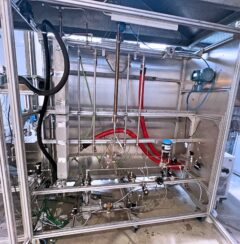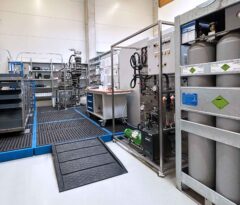There are various concepts and processes available for the capture and further utilisation of CO2 from industrial waste gases, which all have their different advantages and disadvantages. In addition to the level of technical maturity, the investment requirements and the running costs are decisive factors in evaluating and deploying these concepts. Two major lead projects are currently researching and trialing pioneering CCU technologies for a sustainable carbon cycle.
ZEUS (Zero Emissions throUgh Sector Coupling)
Partners from the energy sector, industry and research1 are working together in the ZEUS lead project led by K1-MET to trial the production of green hydrogen and the recycling of renewable gases and liquid hydrocarbons based on examples from the steel and cement industries. Various technologies are being researched, tested and in some cases combined with each other for this in the industrial environment (see eia 02/2024).
www.wiva.at/project/zeus
![]() CO2 ELECTROLYSIS
CO2 ELECTROLYSIS
The electrochemical conversion of CO2 is an innovative approach to the production of sustainable chemical raw materials. Similar to an electrolysis cell for water, CO2 can be continuously converted into products that contain carbon such as synthesis gas (a mixture of CO and H2) or formic acid in an electrochemical cell using renewable electricity. The catalyst used and its integration into the electrochemical cell, the cell design and the optimisation of the process parameters are all crucial factors. By controlling the process parameters, for example, the CO/H2 ratio in the product gas can be flexibly adjusted. Two pilot plants are being implemented as part of the ZEUS project: one in the steel industry at voestalpine Stahl GmbH (product: synthesis gas) and one in the cement industry (Rohrdorfer in Gmunden, product: formic acid). The project objective is to demonstrate this technology for the first time using real CO2 from industrial waste gases and for recycling CO2 at both industrial sites. Both plants are among the largest in the world with a scale of 5 kg/h.
![]() CATALYTIC METHANATION
CATALYTIC METHANATION
This process involves synthetic methane (SNG) being formed from the input materials green hydrogen (H2) and carbon dioxide (CO2). H2 and CO2 react at an elevated temperature (250–400°C) and elevated pressure (4–15 bar) in a reactor that is operated on a continuous basis to form the desired SNG. The ZEUS project involves the implementation of a 100 kW pilot plant (around 10 Nm³/h SNG as product gas) with the technology being trialed for the first time in the steel industry at voestalpine Stahl GmbH/K1-MET GmbH in Linz. The research is focused on the dynamic operating mode and the investigation of various catalysts developed by the Chair of Process Technology and Environmental Protection at the University of Leoben. The process involves the use of real gases, green hydrogen from the 6 MW PEM electrolysis plant operated by voestalpine Stahl GmbH/Verbund AG, as well as CO2, which has been separated from the voestalpine Stahl GmbH power plant flue gas by amine scrubbing. The objective is to achieve a high rate of conversion of CO2 into SNG and high catalyst stability. The synthetic methane produced will be reused in the steel industry to create a closed CO2 cycle.
1 PROJECT PARTNERS: K1-MET GmbH, Energy Institute at the Johannes Kepler University Linz, Institute of Organic Chemistry – Johannes Kepler University Linz, GIG Karasek GmbH, The University of Leoben – Chair of Process Engineering for Industrial Environmental Protection, Rohrdorfer Zement – Zementwerk Hatschek GmbH, TU Wien – Institute of Chemical, Environmental and Bioscience Engineering, Verbund AG, voestalpine Stahl GmbH, WIVA P&G – Hydrogen Initiative Flagship Region Austria Power & Gas
Carbon – Cycle Economy Demonstration (C-CED)
Industrial and research partners1 are currently investigating various technologies for CO2 separation from real gases as well as the utilisation of CO2 through methanation in the lead project coordinated by RAG Austria AG.2 Amine scrubbing for the separation of CO2 from steel industry waste gases has been demonstrated in a pilot plant at the voestalpine Stahl GmbH site in Linz since 2023 (see eia 03/2024).
www.wiva.at/project/c-ced
![]() CO2 UTILISATION THROUGH BIOLOGICAL METHANATION
CO2 UTILISATION THROUGH BIOLOGICAL METHANATION
Bioelectrochemical systems have been subject to scientific investigations for many years as an environmentally friendly method for converting CO2 into valuable compounds such as methane. These processes involve the introduction of microorganisms into the cathode chamber of an electrochemical cell. An external voltage is applied to this cell and hydrogen is produced. The microorganisms colonise the electrode and serve as biocatalysts for the conversion of CO2 with hydrogen into synthetic methane. CO2 is captured in the amine scrubber as part of the C-CED project at the voestalpine Stahl GmbH site, before being then fed into a bioelectrochemical system to produce synthetic methane (currently on a laboratory scale). As the main component of natural gas, methane could then be reused in industry or to generate electricity, thereby closing the carbon cycle.
![]() SEPARATION OF CO2 FROM THE ATMOSPHERE
SEPARATION OF CO2 FROM THE ATMOSPHERE
Another innovative technology being researched as part of the lead project is the Direct Air Capture (DAC) process. This technology captures carbon dioxide directly from ambient air rather than from stationary emission sources, such as industrial plants or power stations. The DAC technology has the potential to play a crucial role in closing carbon cycles, particularly in sectors like aviation. Furthermore, the CO2 captured from the atmosphere could serve as a sustainable carbon source in the future. Conventional methods for CO2 separation are not well-suited for DAC applications due to the low concentration of CO2 in the air. To address this challenge, the company Axiom has developed an innovative process for separating CO2 from the atmosphere. This process can provide diluted atmospheric CO2 in a concentrated and virtually 100% pure state, regardless of the location. At the heart of this technology are two potassium carbonate circuits coupled with a multi-layer bipolar electrodialysis stack. The primary goal of the DAC technology is to supply carbon for the synthesis of sustainable fuels and hydrocarbons. The new process was first tested in cooperative research projects. Since 2023, Axiom has been conducting experimental operations at its premises in Ebreichsdorf, Lower Austria. Initial batches of concentrated atmospheric CO2 from these tests have already been utilized by project partners as a carbon source for experimental production of SAFs (Sustainable Aviation Fuels) within the EU Ecofuel project.³ Ongoing efforts in the follow-up C-CED project⁴ are exploring various scenarios for integrating the DAC process into a closed carbon cycle.
1 PROJECT PARTNERS: RAG Austria AG (project coordination), ACIB GmbH; Axiom angewandte Prozesstechnik GmbH, Energie AG Upper Austria, Energy Institute at JKU Linz, K1-MET GmbH, University of Natural Resources and Life Sciences, Vienna – Department IFA Tulln Institute of Environmental Biotechnology, WIVA P&G, voestalpine Stahl GmbH
2 www.rag-austria.at/forschung-innovation/carbon-cycle-economy-demonstration.html
3 Credits and partners in the EcoFuel project: www.ecofuel-horizon.eu
4 Credits and partners in the C-CED project: www.wiva.at/project/c-ced
Both lead projects are being implemented as part of the WIVA P&G – Hydrogen Initiative Flagship Region Austria Power & Gas.
www.wiva.at


